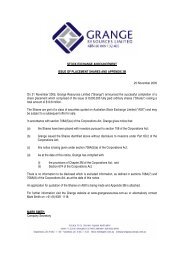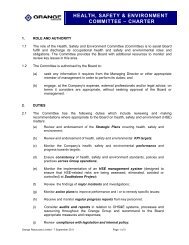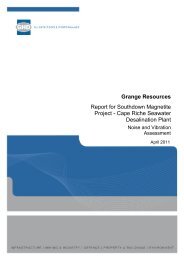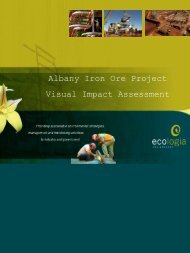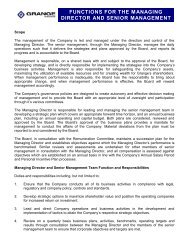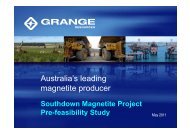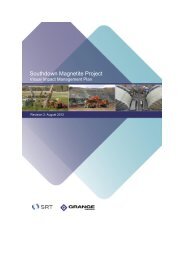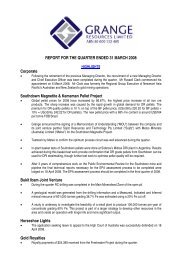2012 Annual Report (2 April 2013) - Grange Resources
2012 Annual Report (2 April 2013) - Grange Resources
2012 Annual Report (2 April 2013) - Grange Resources
You also want an ePaper? Increase the reach of your titles
YUMPU automatically turns print PDFs into web optimized ePapers that Google loves.
<strong>2012</strong> ANNUAL REPORT<br />
13<br />
PAGE<br />
MINERAL RESOURCES AND ORE RESERVES - SAVAGE RIVER<br />
OPERATIONS<br />
The following tables show the Mineral <strong>Resources</strong> and Ore Reserves for the Savage River<br />
operations as at 30 June <strong>2012</strong>. Mining of ore through this period was focussed on high<br />
grade supply from the Stage 1 area of North Pit. The increase in resources from 2011 is<br />
due to the inclusion of the resource estimation for the Long Plains deposit (as announced<br />
to the ASX on 30 August <strong>2012</strong>).<br />
Mineral <strong>Resources</strong> and Ore Reserves are categorised in accordance with the Australasian<br />
Code for Exploration Results, Mineral <strong>Resources</strong> and Ore Reserves of December 2004<br />
(JORC Code, 2004). Estimated Measured and Indicated Mineral <strong>Resources</strong> include<br />
those Mineral <strong>Resources</strong> modified to produce the estimated Ore Reserves. Mineral<br />
<strong>Resources</strong> which are not included in the Ore Reserves did not meet the required<br />
economic viability hurdle at the time of last review.<br />
Mineral <strong>Resources</strong><br />
A summary of the total Mineral <strong>Resources</strong> for Savage River as at 30 June <strong>2012</strong> (including<br />
the mineral resource estimate for the Long Plains deposit that was announced to the ASX<br />
on 30 August <strong>2012</strong>) is as follows:<br />
As at June <strong>2012</strong> As at June 2011<br />
Tonnes Grade Tonnes Grade<br />
(Mt) % DTR* (Mt) % DTR*<br />
Measured 78.2 54.2 81.4 54.2<br />
Indicated 135.7 53.5 131.5 53.5<br />
Inferred 129.8 47.2 86.9 48.8<br />
Total 343.7 51.3 299.8 52.3<br />
* Davis Tube Recovery – a measure of recoverable magnetite<br />
Ore Reserve<br />
A summary of the ore reserve for Savage River as at 30 June <strong>2012</strong> is as follows:<br />
As at June <strong>2012</strong> As at June 2011<br />
Tonnes Grade Tonnes Grade<br />
(Mt) % DTR* (Mt) % DTR*<br />
Proved 44.6 52.2 47.6 51.6<br />
Probable 64.8 52.1 66.3 51.4<br />
Total 109.4 51.8 113.9 51.5<br />
* Davis Tube Recovery – a measure of recoverable magnetite<br />
The information in this release that relates to Exploration Results or Mineral <strong>Resources</strong> in relation to the<br />
Savage River Project is based on information compiled by Mr Ben Maynard, who is a Member of the<br />
Australasian Institute of Mining and Metallurgy and is a full time employee of <strong>Grange</strong> <strong>Resources</strong> Limited.<br />
Mr Maynard has sufficient experience which is relevant to the style of mineralisation and type of deposit<br />
under consideration and to the activity which he is undertaking to qualify as a Competent Person as<br />
defined in the 2004 Edition of the ‘Australasian Code for <strong>Report</strong>ing of Exploration Results, Mineral<br />
<strong>Resources</strong> and Ore Reserves’. Mr Maynard consents to the inclusion in the release of the matters based<br />
on his information in the form and context in which it appears.<br />
The classification of Mineral <strong>Resources</strong><br />
was considered appropriate on the<br />
basis of drill hole spacing, sample<br />
interval, geological interpretation and<br />
representativeness of assay data and was<br />
based on a number of factors:<br />
◆◆<br />
◆◆<br />
◆◆<br />
◆◆<br />
◆◆<br />
◆◆<br />
◆◆<br />
◆◆<br />
◆◆<br />
◆◆<br />
The Measured and Indicated<br />
Mineral <strong>Resources</strong> are inclusive of<br />
those Mineral <strong>Resources</strong> modified<br />
to produce the Ore Reserves. The<br />
Inferred Mineral <strong>Resources</strong> are,<br />
by definition, additional to the Ore<br />
Reserves.<br />
The estimation was constrained within<br />
the interpreted geological domains.<br />
The Ordinary Kriging (OK) and Inverse<br />
Distance interpolation methods were<br />
carried out on drilling data composited<br />
to 2 metres as appropriate for the<br />
different parts of the deposit. OK and<br />
1 metre composites were used for<br />
Long Plains.<br />
Oxidised material was not included in<br />
this statement of Mineral <strong>Resources</strong>.<br />
Tonnages were estimated on a dry<br />
basis.<br />
Bulk density for samples taken from<br />
diamond drill core has been physically<br />
determined by the weight-in-air/<br />
weight-in-water method. Samples are<br />
unsealed during this process as most<br />
material is competent and/or of low<br />
porosity.<br />
A lower cut-off grade of 15% DTR<br />
was used in the calculation of both the<br />
Mineral <strong>Resources</strong> and Ore Reserves.<br />
The Ore Reserve was calculated using<br />
a 1.087 dilution factor and a mining<br />
recovery factor of 0.939. These factors<br />
are based on periodic reconciliation<br />
specific to mining areas.<br />
A risk factor of 0.8 was applied to the<br />
Centre Pit South reserve for potential<br />
loss due to wall instability. Studies will<br />
be undertaken to mitigate this risk.<br />
The survey surface used for reporting<br />
was the end-of-month June <strong>2012</strong><br />
surface.



